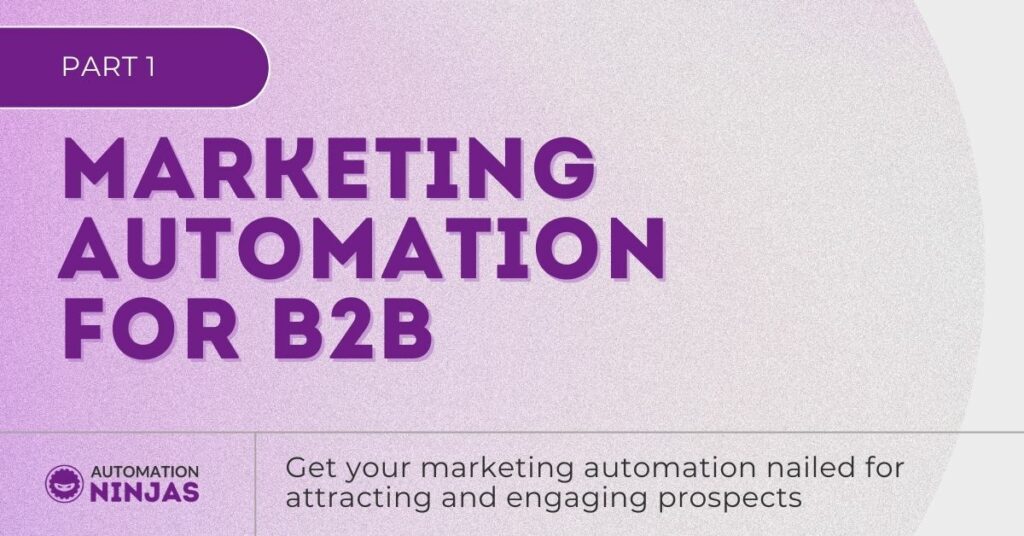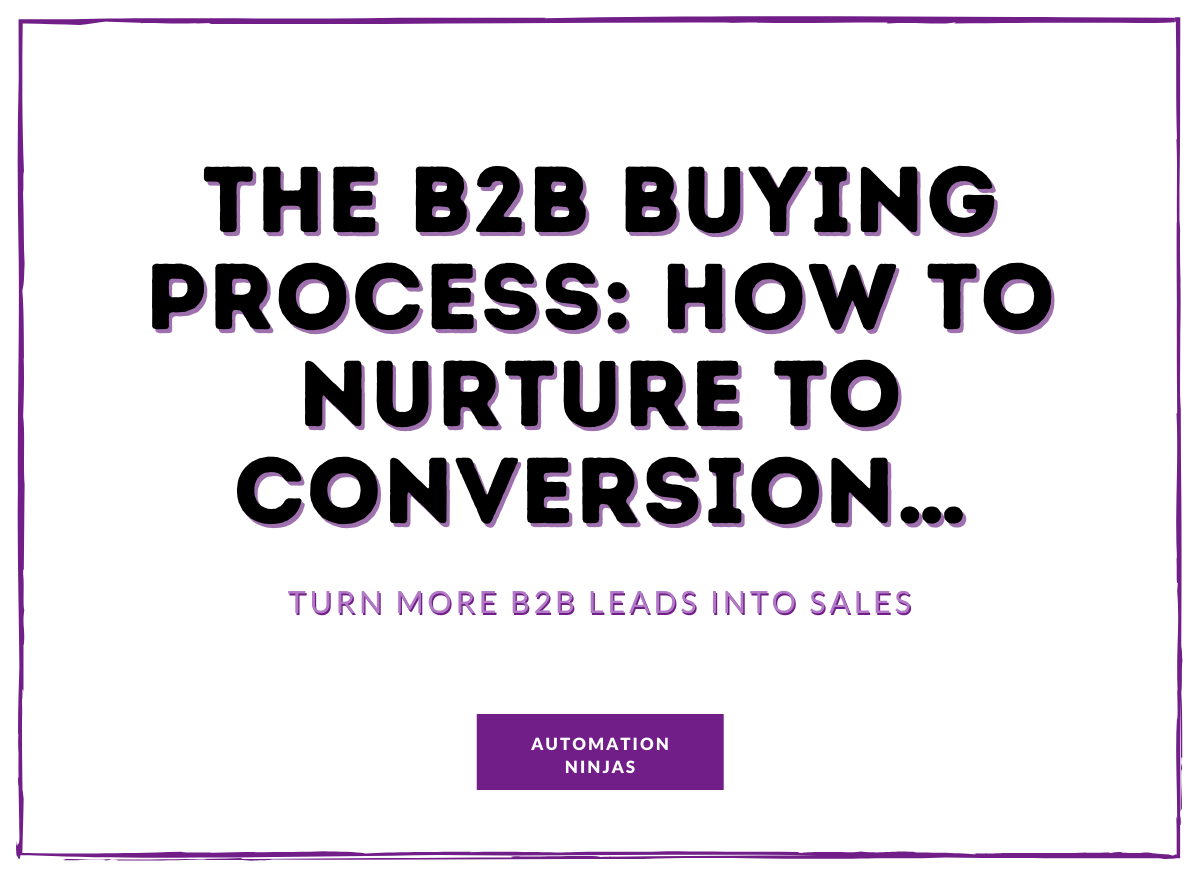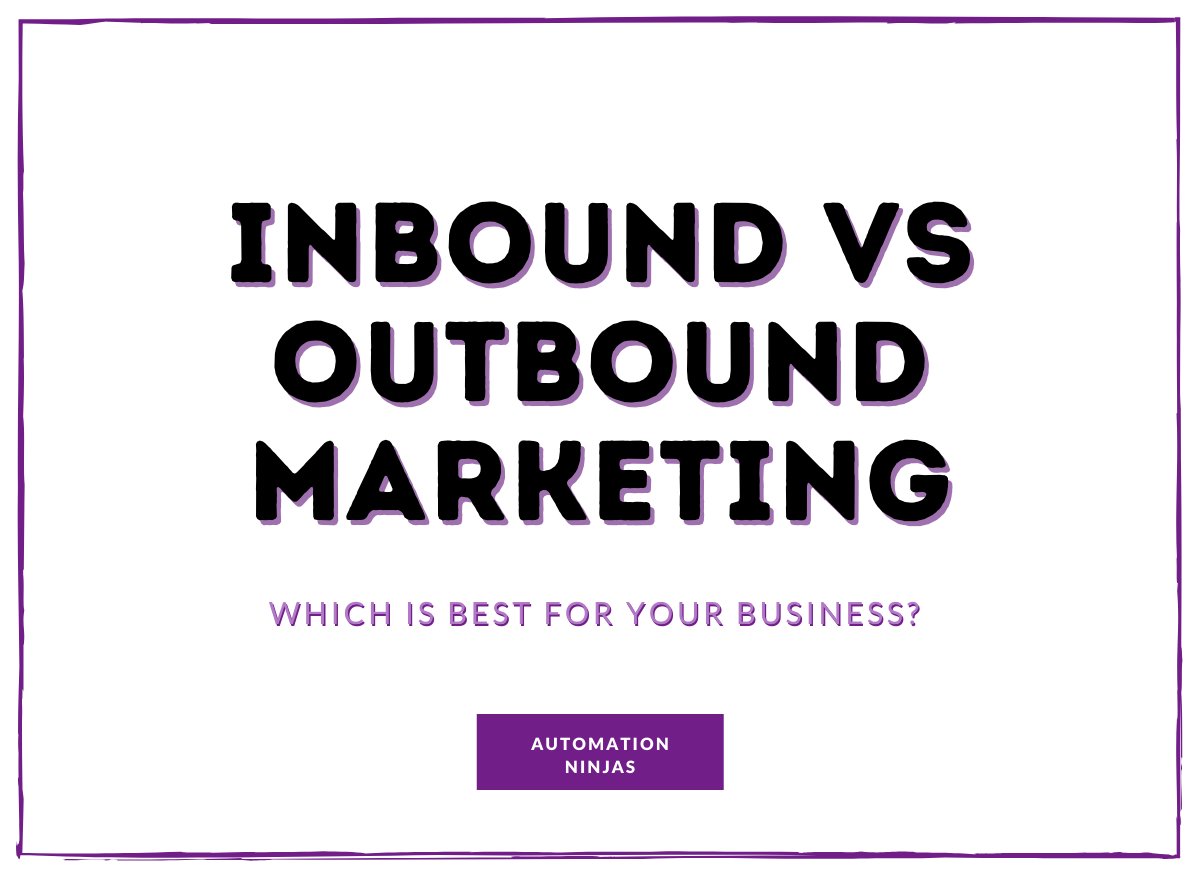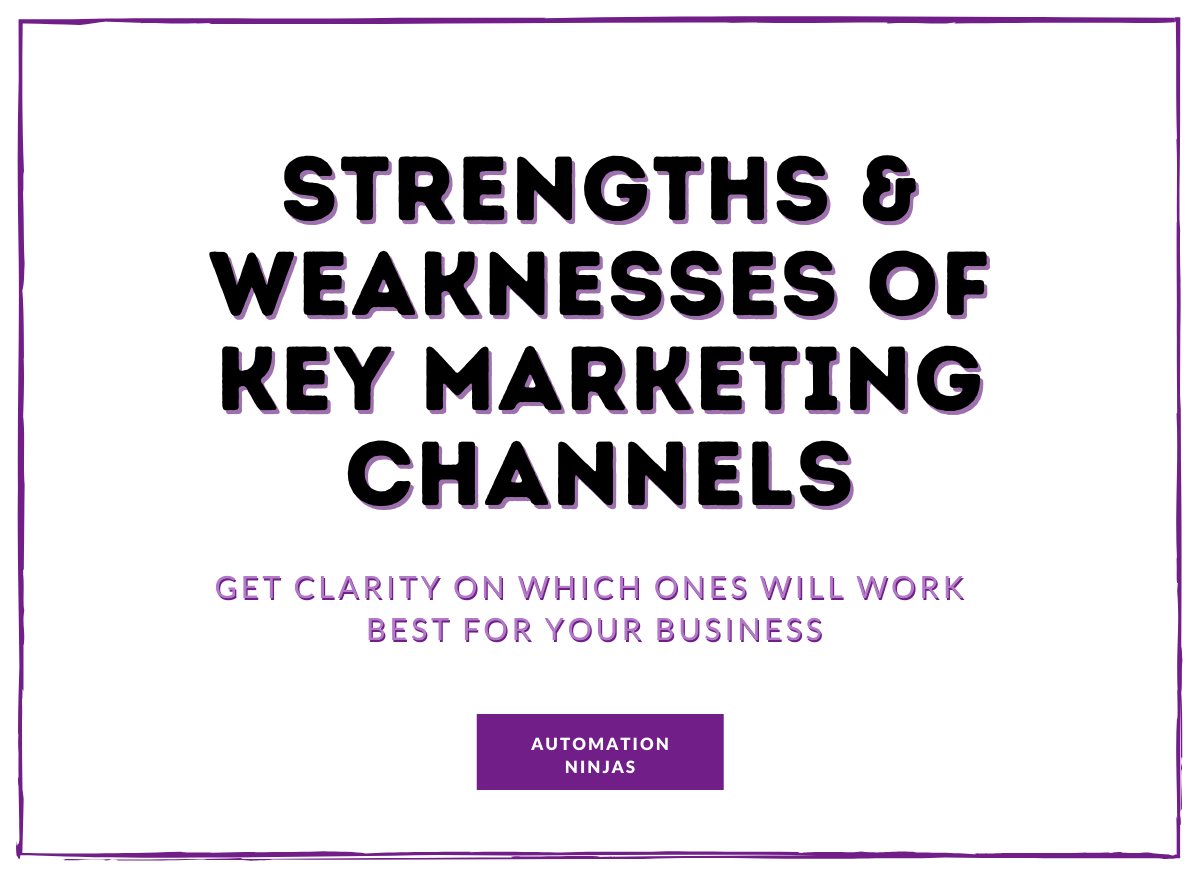Author: Ashton Oldham
Hey there, I'm Ashton, the Content Ninja with a penchant for creativity! I'm all about crafting killer customer-focused content and sprinkling it with that special sauce that makes brands pop. Teaching, strategising, organising (people and projects), and spicing up collaborations? That's my jam!
Let me start by saying this could be a dry blog series; desert level stuff. After all, Marketing Automation for B2B doesn’t come across as the sexiest topic at first glance, right?
But here at Automation Ninjas, we are ALL about marketing automation. And, if it wasn't at least a little ooh la la, we wouldn’t love what we do.
This is Part 1 of the Marketing Automation for B2B series.
In this blog, we’re going to chat about the core of marketing automation and dive into the customer journey. Well, the first part at least. We’re going to focus on the Attract and Engage sections of the journey. Then in Part 2, the second half of the journey will be acknowledged: Sell & Wow.
My aim is that by the end of your reading, you will be buzzing to implement some effective strategies to put a bit of powwow into your marketing.
If you can master Marketing Automation for your B2B business, it will help you scale by strengthening lead volume and quality, increasing conversions, saving you valuable time, and bringing you more business.
By the way… If you were thinking this is a tech-first blog, it isn’t. I do talk a bit about tech at the end, but you're currently in the wrong place for a comparison table of automation tools on the market.
Before you rush off back to Google, I would suggest you read this blog. As I will remind you at the end of this post, “talking tech before understanding why you are doing something, how you should do it, and what you are trying to achieve is pointless”.
So, humour me for a while 😉
Marketing Automation for B2B businesses - What is it?
Right. Let’s get the bore.com part of this blog out of the way. Here’s a little descriptor that if you are new to marketing automation, will get you somewhat clued up.
Marketing automation is a combination of processes and technology used to automate, deliver and measure customer journeys.
Predominantly, this consists of software that automates tasks, workflows and campaigns. However, that's just the tip of the iceberg.
PS. If the term customer journey is new to you too, hop over to our blog on Customer Journey Mapping to get yourself acquainted. The customer journey is going to be the backbone of what we discuss here, so it’s crucial you know what it is 🙂
Make sure to come straight back here though, we are going to take that learning even deeper!
There are oodles of moving parts in modern marketing. Without automation it would be near impossible to ensure each one is well executed and provides awesome ROI.
10 Types of Marketing Automation for B2B
- Customer relationship management
- Marketing funnel > sales funnel
- Email marketing
- CMS/website - landing pages, web forms
- Social media marketing
- Customer re-engagement
- Lead generation
- Advertising and promotion
- Reporting and analytics
- Workflows and project management,
Of course, this isn’t an exhaustive list - but for the most part, these are the core automations businesses will be using.
Marketing Automation for B2B vs B2C: Are there differences?
This is something we often get quizzed on. Undoubtedly there are a number of differences. However, every single business will have a customer journey (even if they don’t have it down on paper).
All customers, whether in the e-commerce realm or B2B, will go through a set of stages from being unknown prospects to, hopefully, lifelong customers.
During this time they need to be treated in a very similar manner. After all, they are all humans at the end of it and we need to cater for that - that’s where psychology comes in. Don’t worry - we’re not going into that just yet, let’s keep things a bit simpler for now.
In most (but not all) cases a B2C buyer makes purchase decisions themselves. Sometimes this can be on impulse, sometimes it’s based on their own research and requires more time to consider.
Whereas in B2B, the consideration and research can often be much more in-depth, time-consuming and involve more decision-makers.
If you are B2B, you will likely have more systems in place to manage the relationship from prospect to customer. This could be something like Salesforce CRM - allowing you to create a sales funnel and have account managers in place to look after the SQLs (sales qualified leads).
On the other hand, a B2C business will likely have an e-commerce platform in use, such as Shopify. These are the main differences in tech. But, there are a lot of similarities too, such as email marketing platforms, social media sites, website pages and forms.
The Customer Journey & Lifecycle Framework
Earlier I mentioned how flippin’ crucial it is to be clear on your customer journey. If you didn’t get a chance to check out the blog I linked, I’ve popped an image below that showcased our customer journey model.
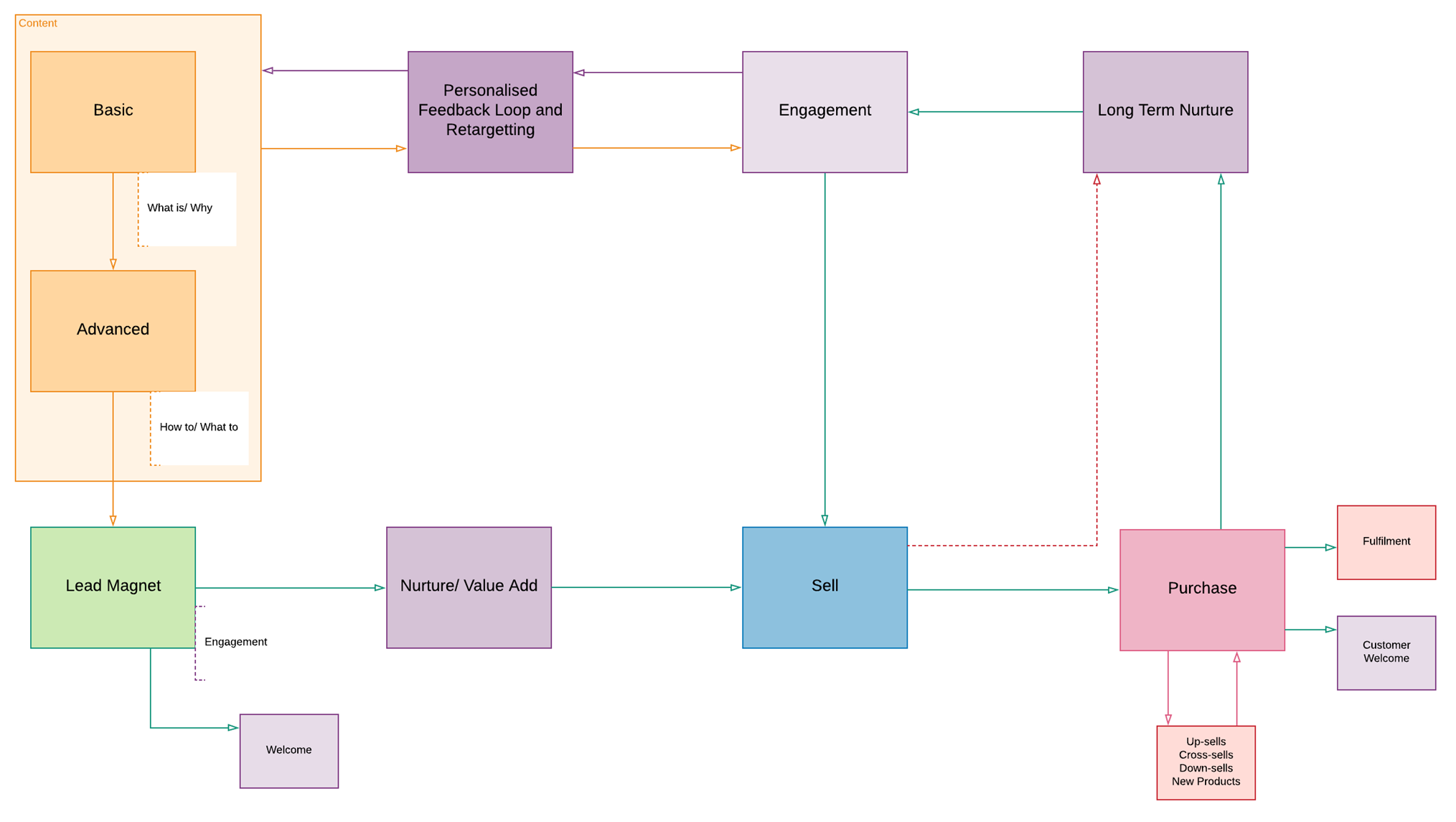
As a recap, this model can be adapted to any business. We have designed it as such.
Once you have your journey mapped out, you can start to identify the four key parts that make up this framework: Attract, Engage, Sell & Wow.
You can see these areas demonstrated in the customer journey thanks to the colours. Orange = General Content Creation, Green = Attract, Purple = Engage, Blue = Sell, Pink = Wow.
We call this framework “Lifecycle Marketing”.
Again, we have already written an in-depth blog on this subject, so instead of repeating ourselves here, you can pop over to ‘What is Lifecycle Marketing?’ and meet me back here when you are done on the learning front.
Right, we’re going to jump into the first half of that framework for you. Let’s break down what key things you should be doing to Attract & Engage when it comes to Marketing Automation for B2B.
Attract for B2B Marketing
The first phase is about how you attract new customers to your business. Pretty straightforward.
You should have the following in place as part of your ‘attract’ strategy. Unless building your list of subscribers and increasing the number and quality of leads isn’t of interest to you?
Attract is divided into three sections:
1. Targeting
To target effectively, you must first understand your market. Who are the people that make up your target market? You must know who they are, and what they care about and want (in relation to what it is you are offering them).
If you aren’t clear on this, you're going to struggle to attract the right customers.
2. Attracting interest
When you have this information, you must use it to create content that will grab their attention. Talk about things they care about and discuss their challenges, desires, and aspirations. It’s also crucial to create content for each stage of awareness.
Psst. We'll go into awareness later in this blog, so hang tight!
You should be blogging, and have a presence on social media, or forums - depending on where they hang out, you might want to use targeted ads - but be cautious of ROI, your website should be catered to attracting new business and for the love of Pete, you must have lead magnets in place.
Lead magnets are incredibly powerful for lead gen and nurturing. Get them right and they are irresistible to the right people, attracting them like moths to a flame.
They are pieces of consumable content that provide amazing value to the consumer. And, they come in a wide variety of types and formats. The commonality is that a person has to enter their details (generally name and email address) in order to access the piece of content.
That swiftly leads us to the last piece of the puzzle:
3. Collecting leads
Forms. That’s how you collect leads. Forms everywhere! They don’t need to be complicated, as I said above a name and an email address are all you really need to start building a relationship with someone.
Of course, you will have forms that ask for further information, depending on what you use them for: contact forms, sign-ups for blogs/newsletters, product deals and discounts, etc.
You need to collect all your leads in a CRM system. A one-stop shop where you can manage your entire business relationship with them.
So, where does Marketing Automation come into the picture?
Right from the get-go!
Your website, ads, content - everything - should be utilising marketing automation.
Get your Attract Strategy into great shape with our Attract Playbook. We’ll take you step-by-step through what you need to set up for targeting and attracting new leads to your business.
Engage for B2B Marketing
Though I am including ‘Engage’ in the first part of this blog series, it actually fits into every stage of the customer journey. It’s the biggest cog in the marketing automation machine.
It’s the bit I want you to really focus on and heed my advice. Nail your engagement strategy and you are already winning my friend!
Let’s crack on with why engage is so darn juicy and how it slots into Marketing Automation for B2B.
The Awareness Journey
Ok, I bet you are wondering where I’ve shot off all of a sudden. First I was talking about a customer journey, now an awareness journey?!
I know, right. But it’s crucial to understand this to create a strategic engagement plan for your entire audience. So, stick with me!
Take a look at the image below and follow through the stages. I’ve popped arrows in to make that super easy…
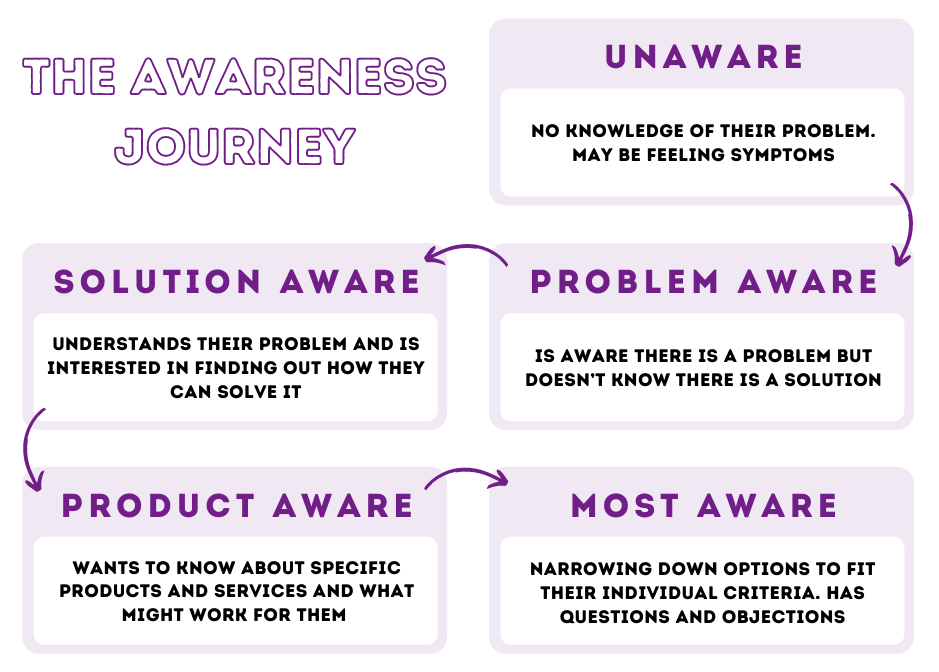
Unaware
Everyone starts off unaware. At some point. They may come to you further into the journey, but the idea is that we are all unaware of our main problems in the beginning.
And that is why your business exists. To help solve the problems another business is dealing with, whatever they may be. And you may do this via products or services you offer.
In the unaware stage, we are feeling symptoms of this problem. They may feel like a bunch of mini-problems, a collective if you will.
This isn’t nice. We want to figure out what the heck is going on. So, we take to researching - in a variety of ways.
Problem Aware
Through this research; consumption of content, we learn that we have a problem (or more than one maybe). We have an AHA moment. Something clicks and we can put our finger on what’s causing our difficulties. We become problem aware.
From here we want to a) understand our problem deeper, and b) if there is a solution to the problem. Initiate research stage two.
Solution Aware
During our research - more consumption of content - we discover that yes, there are solutions. Thank the stars, we can overcome this problem.
However, more than likely we are presented with a wide-ranging choice of solutions. And we aren’t yet sure which one to pick. Right now we are solution aware. We’ve got some answers but we need to find the one ring to rule them all.
The product or service that will fix our problem, for good.
What’s next? You guessed it, more research, more content consumption.
Product Aware
We do this until we become product aware. At this stage, we’ve started getting really picky. Already we have built base criteria for what we want and need, and we’re sifting through the options to find what can provide us with that.
Until now, most of the content we have been absorbing has been focused on educating us about specific problems and solutions. We’ve not been ready to buy, because we weren’t sure what we actually wanted or needed yet.
But at product aware we are far clearer. We want specifics, the type of content we are now ready to consume has changed somewhat. I’ll get on to that in just a minute.
Most Aware
While we are comparing the product/service offerings that suit our criteria, we manage to whittle it down to just a couple or so options.
We are now most aware. And by the way, we have decided whether your business is a possible fit by this point. If you haven’t made the cut, it’s likely there’s not much you can do.
Unfortunately, you have to accept that your provision might not be the best choice for everyone.
Now we are most aware we are still consuming content, but we are likely asking questions, speaking to human beings and getting ready to make a purchase decision. Our journey as a prospect is coming to an end.
Using awareness in your engagement strategy
Now you are clear on the stages, I want to explain how it fits into your engagement strategy.
You MUST be creating content for each stage of awareness.
There are no two ways about it. If you don’t do this you will lose potential customers. You are the expert, you have the solution (more than likely), and it’s your job to educate them and carry them from unaware to most aware.
And, you do this with content in its wide variety of forms.
It’s crucial to understand the type of content, and the messaging you use at each awareness stage too.
For the unaware and problem aware stages, you should really avoid the sales spiel. As I said, they are still trying to figure things out, it's highly unlikely they are going to buy from you straight up. Yes, it happens, but not regularly.
Save your powerful sales messaging for when they are researching products and comparing you to your competitors. Offer it up when they are product aware and most aware.
PS. Here's a top tip for sales too: make it about them, not you.
When they are learning about their problem, they want to be educated. They also want to be validated. Speak to them as people. Yes, even if they are B2B.
Talk to their interests, desires, values, motivations and aspirations. Be relatable and connect with them. Showcase your expertise, show them you care.
You should be doing this during the entire customer journey, even after they purchase from you, especially after they purchase from you.
Engagement continues after purchase
I love reminding marketers that their job doesn’t stop when a sale is made. It’s commonplace to think that you’ve passed the buck onto your sales and fulfilment team, but nooooo.
As a marketing professional, I am all in for being part of the customer journey, right to the very end. It makes me feel rather important 😀
We talk a lot about demand generation. It’s a bit of a buzz term I know, but demand generation is often misconstrued as attracting leads and getting them into a sales funnel. And, that’s it.
But, the work continues.
Demand generation is everything you do to get and keep a customer.
Customer retention is a biggie. And we won’t get into detail on it here, that’s for another blog. I just wanted to bring that into this one as a reminder.
Marketing Automation for B2B goes from the tippy top; attracting leads, to the very bottom; keeping your customers happy and willing to spend more with you.
Why should you care so much about engagement?
A high level of content engagement is what all us marketing folk strive for. Especially people like me, a Content Manager, there’s not much else!
But why should businesses and people outside of the marketing realm care?
As our Head Ninja, Kenda, put it simply, “If you don't engage with your audience they will simply ignore you.”
And an ignored business is a failing one.
Get your hands on our Engage Playbook to start engaging and nurturing your audience like a total pro Ninja. Go lay great foundations, complete the educational exercises and action the plays we have created. To your success!
Where does Marketing Automation for B2B fit into all of this?
At the start of this blog, I made it clear this wasn’t going to be all about the tech. And, said I would remind you of why: talking tech before understanding why you are doing something, how you should do it, and what you are trying to achieve is pointless.
But choosing tech, I know, is also important. We use so many different platforms in our business because of the pool of clients we work with. Therefore, we do have a lot of expertise in this area.
Our tech kings and queens would love to help you figure out what tools are the right ones for your business. And would be happy to have a conversation with you. Complete this form if you’d like to speak to a Ninja.
My hope is that now you know what you need to be doing, it will be easier to shortlist the tools available to you to what fits your needs better.
If you’re still in that stage of researching and consuming content, I’ve come across an external blog which may be of use to you: The 7 Best Marketing Automation Tools & Platforms in 2022 by Woopra. There’s a breakdown of popular automation tools if you’d like a look.
FYI, our CRM, Sales & Marketing system of choice is Keap (formerly Infusionsoft) but we have access to and use other platforms such as HubSpot, ActiveCampaign, Klaviyo, Shopify, Salesforce, ConvertKit, MailChimp, Marsello, Zapier, Zoho, Slack, ClickUp, TeamWork - just to name a few!
Whatever marketing automation tools you choose to implement, you must make sure they support what you want to do within your customer journey. That should always come first!
Get clear on those things, create your criteria and then go researching tech, not the other way around.

Sign up to the Brainbox to stay in the loop with the latest marketing news and exclusive content
Or, if you have something specific in mind, reach out to us directly. We're all ears and ready to chat! Contact us here.

